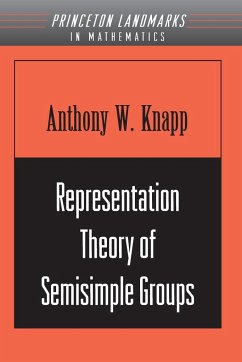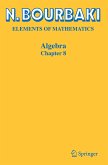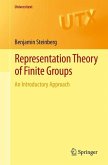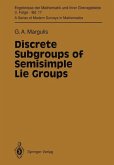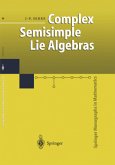- Broschiertes Buch
- Merkliste
- Auf die Merkliste
- Bewerten Bewerten
- Teilen
- Produkt teilen
- Produkterinnerung
- Produkterinnerung
In this classic work, Anthony W. Knapp offers a survey of representation theory of semisimple Lie groups in a way that reflects the spirit of the subject and corresponds to the natural learning process. This book is a model of exposition and an invaluable resource for both graduate students and researchers. Although theorems are always stated precisely, many illustrative examples or classes of examples are given. To support this unique approach, the author includes for the reader a useful 300-item bibliography and an extensive section of notes.
Andere Kunden interessierten sich auch für
![Complex Semisimple Quantum Groups and Representation Theory Complex Semisimple Quantum Groups and Representation Theory]() Christian VoigtComplex Semisimple Quantum Groups and Representation Theory47,99 €
Christian VoigtComplex Semisimple Quantum Groups and Representation Theory47,99 €![Algebra Algebra]() N. BourbakiAlgebra108,99 €
N. BourbakiAlgebra108,99 €![Algebra Algebra]() N. BourbakiAlgebra100,99 €
N. BourbakiAlgebra100,99 €![Representation Theory of Finite Groups Representation Theory of Finite Groups]() Benjamin SteinbergRepresentation Theory of Finite Groups47,99 €
Benjamin SteinbergRepresentation Theory of Finite Groups47,99 €![Discrete Subgroups of Semisimple Lie Groups Discrete Subgroups of Semisimple Lie Groups]() Gregori A. MargulisDiscrete Subgroups of Semisimple Lie Groups105,99 €
Gregori A. MargulisDiscrete Subgroups of Semisimple Lie Groups105,99 €![Non-Semisimple Topological Quantum Field Theories for 3-Manifolds with Corners Non-Semisimple Topological Quantum Field Theories for 3-Manifolds with Corners]() Thomas KerlerNon-Semisimple Topological Quantum Field Theories for 3-Manifolds with Corners41,99 €
Thomas KerlerNon-Semisimple Topological Quantum Field Theories for 3-Manifolds with Corners41,99 €![Complex Semisimple Lie Algebras Complex Semisimple Lie Algebras]() Jean-Pierre SerreComplex Semisimple Lie Algebras48,99 €
Jean-Pierre SerreComplex Semisimple Lie Algebras48,99 €-
-
-
In this classic work, Anthony W. Knapp offers a survey of representation theory of semisimple Lie groups in a way that reflects the spirit of the subject and corresponds to the natural learning process. This book is a model of exposition and an invaluable resource for both graduate students and researchers. Although theorems are always stated precisely, many illustrative examples or classes of examples are given. To support this unique approach, the author includes for the reader a useful 300-item bibliography and an extensive section of notes.
Hinweis: Dieser Artikel kann nur an eine deutsche Lieferadresse ausgeliefert werden.
Hinweis: Dieser Artikel kann nur an eine deutsche Lieferadresse ausgeliefert werden.
Produktdetails
- Produktdetails
- Verlag: Princeton University Press
- Seitenzahl: 794
- Erscheinungstermin: 7. Oktober 2001
- Englisch
- Abmessung: 234mm x 156mm x 43mm
- Gewicht: 1182g
- ISBN-13: 9780691090894
- ISBN-10: 0691090890
- Artikelnr.: 21750633
- Herstellerkennzeichnung
- Libri GmbH
- Europaallee 1
- 36244 Bad Hersfeld
- gpsr@libri.de
- Verlag: Princeton University Press
- Seitenzahl: 794
- Erscheinungstermin: 7. Oktober 2001
- Englisch
- Abmessung: 234mm x 156mm x 43mm
- Gewicht: 1182g
- ISBN-13: 9780691090894
- ISBN-10: 0691090890
- Artikelnr.: 21750633
- Herstellerkennzeichnung
- Libri GmbH
- Europaallee 1
- 36244 Bad Hersfeld
- gpsr@libri.de
Anthony W. Knapp With a new preface by the author
Preface to the Princeton Landmarks in Mathematics Edition xiii
Preface xv
Acknowledgments xix
CHAPTER I. SCOPE OF THE THEORY
1. The Classical Groups 3
2. Cartan Decomposition 7
3. Representations 10
4. Concrete Problems in Representation Theory 14
5. Abstract Theory for Compact Groups 14
6. Application of the Abstract Theory to Lie Groups 23
7. Problems 24
CHAPTER II. REPRESENTATIONS OF SU(2), SL(2,R), AND SL(2,C)
l. The Unitary Trick 28
2. Irreducible Finite-Dimensional Complex-Linear Representations of 91(2,C)
30
3. Finite-Dimensional Representations of 91(2,C) 31
4. Irreducible Unitary Representations of SL(2,C) 33
5. Irreducible Unitary Representations of SL(2,08) 35
6. Use of SU(1,1) 39
7. Plancherel Formula 41
8. Problems 42
CHAPTER III. C VECTORS AND THE UNIVERSAL ENVELOPING ALGEBRA
l. Universal Enveloping Algebra 46
2. Actions on Universal Enveloping Algebra 50
3. C Vectors 55
4. Garding Subspace. Problems 57
CHAPTER IV. REPRESENTATIONS OF COMPACT LIE GROUPS
1. Examples of Root Space Decompositions 60
2. Roots 65
3. Abstract Root Systems and Positivity 72
4. Weyl Group, Algebraically 78
5. Weights and Integral Forms 81
6. Centalizers of Tori 86
7. Theorem of the Highest Weight 89
8. Verma Modules 93
9. Weyl Group, Analytically 100
10. Weyl Character Formula 104
11. Problems 109
CHAPTER V. STRUCTURE THEORY FOR NONCOMPACT GROUPS
l. Cartan Decomposition and the Unitary Trick 113
2. Iwasawa Decomposition 116
3. Regular Elements, Weyl Chambers, and the Weyl Group 121
4. Other Decompositions 126
5. Parabolic Subgroups 132
6. Integral Formulas 137
7. Borel-Weil Theorem 142
8. Problems 147
CHAPTER VI. HOLOMORPHIC DISCRETE SERIES
1. Holomorphic Discrete Series for SU(1,1) 150
2. Classical Bounded Symmetric Domains 152
3. Harish-Chandra Decomposition 153
4. Holomorphic Discrete Series 158
5. Finiteness of an Integral 161
6. Problems 164
CHAPTER VII. INDUCED REPRESENTATIONS
1. Three Pictures 167
2. Elementary Properties 169
3. Bruhat Theory 172
4. Formal Intertwining Operators 174
5. Gindikin-Karpelevic Formula 177
6. Estimates on Intertwining Operators, Part I 181
7. Analytic Continuation of Intertwining Operators, Part I 183
8. Spherical Functions 185
9. Finite-Dimensional Representations and the H function 191
10. Estimates on Intertwining Operators, Part II 196
11. Tempered Representations and Langlands Quotients 198
12. Problems 201
CHAPTER VIII. ADMISSIBLE REPRESENTATIONS
l. Motivation 203
2. Admissible Representations 205
3. Invariant Subspaces 209
4. Framework for Studying Matrix Coefficients 215
5. Harish-Chandra Homomorphism 218
6. Infinitesimal Character 223
7. Differential Equations Satisfied by Matrix Coefficients 226
8. Asymptotic Expansions and Leading Exponents 234
9. First Application: Subrepresentation Theorem 238
10. Second Application: Analytic Continuation of Interwining Operators,
Part II 239
11. Third Application: Control of K-Finite Z(gc)-Finite Functions 242
12. Asymptotic Expansions near the Walls 247
13. Fourth Application: Asymptotic Size of Matrix Coefficients 253
14. Fifth Application: Identification of Irreducible Tempered
Representations 258
15. Sixth Application: Langlands Classification of Irreducible Admissible
Representations 266
16. Problems 276
CHAPTER IX. CONSTRUCTION OF DISCRETE SERIES
1. Infinitesimally Unitary Representations 281
2. A Third Way of Treating Admissible Representations 282
3. Equivalent Definitions of Discrete Series 284
4. Motivation in General and the Construction in SU(1,1) 287
5. Finite-Dimensional Spherical Representations 300
6. Duality in the General Case 303
7. Construction of Discrete Series 309
8. Limitations on K Types 320
9. Lemma on Linear Independence 328
10. Problems 330
CHAPTER X. GLOBAL CHARACTERS
l. Existence 333
2. Character Formulas for SL(2,R) 338
3. Induced Characters 347
4. Differential Equations 354
5. Analyticity on the Regular Set, Overview and Example 355
6. Analyticity on the Regular Set, General Case 360
7. Formula on the Regular Set 368
8. Behavior on the Singular Set 371
9. Families of Admissible Representations 374
10. Problems 383
CHAPTER XI. INTRODUCTION TO PLANCHEREL FORMULA
l. Constructive Proof for SU(2) 385
2. Constructive Proof for SL(2,C) 387
3. Constructive Proof for SL(2,R) 394
4. Ingredients of Proof for General Case 401
5. Scheme of Proof for General Case 404
6. Properties of F f 407
7. Hirai's Patching Conditions 421
8. Problems 425
CHAPTER XII. EXHAUSTION OF DISCRETE SERIES
1. Boundedness of Numerators of Characters 426
2. Use of Patching Conditions 432
3. Formula for Discrete Series Characters 436
4. Schwartz Space 447.
5. Exhaustion of Discrete Series 452
6. Tempered Distributions 456
7. Limits of Discrete Series 460
8. Discrete Series of M 467
9. Schmid's Identity 473
10. Problems 476
CHAPTER XIII. PLANCHEREL FORMULA
1. Ideas and Ingredients 482
2. Real-Rank-One Groups, Part I 482
3. Real-Rank-One Groups, Part II 485
4. Averaged Discrete Series 494
5. Sp (2,R) 502
6. General Case 511
7. Problems 512
CHAPTER XIV. IRREDUCIBLE TEMPERED REPRESENTATIONS
l. SL(2,R) from a More General Point of View 515
2. Eisenstein Integrals 520
3. Asymptotics of Eisenstein Integrals 526
4. The il Functions for Intertwining Operators 535
5. First Irreducibility Results 540
6. Normalization of Intertwining Operators and Reducibility 543
7. Connection with Plancherel Formula when dim A = 1 547
8. Harish-Chandra's Completeness Theorem 553
9. R Group 560
10. Action by Weyl Group on Representations of M 568
11. Multiplicity One Theorem 577
12. Zuckerman Tensoring of Induced Representations 584
13. Generalized Schmid Identities 587
14. Inversion of Generalized Schmid Identities 595
15. Complete Reduction of Induced Representations 599
16. Classification 606
17. Revised Langlands Classification 614
18. Problems 621
CHAPTER XV. MINIMAL K TYPES
l. Definition and Formula 626
2. Inversion Problem 635
3. Connection with Intertwining Operators 641
4. Problems 647
CHAPTER XVI. UNITARY REPRESENTATIONS
1. SL(2,U8) and SL(2,C) 650
2. Continuity Arguments and Complementary Series 653
3. Criterion for Unitary Representations 655
4. Reduction to Real Infinitesimal Character 660
5. Problems 665
APPENDIX A: ELEMENTARY THEORY OF LIE GROUPS
l. Lie Algebras 667
2. Structure Theory of Lie Algebras 668
3. Fundamental Group and Covering Spaces 670
4. Topological Groups 673
5. Vector Fields and Submanifolds 674
6. Lie Groups 679
APPENDIX B: REGULAR SINGULAR POINTS OF PARTIAL DIFFERENTIAL EQUATIONS
1. Summary of Classical One-Variable Theory 685
2. Uniqueness and Analytic Continuation of Solutions in Several Variables
690
3. Analog of Fundamental Matrix 693
4. Regular Singularities 697
5. Systems of Higher Order 700
6. Leading Exponents and the Analog of the Indicial Equation 703
7. Uniqueness of Representation 710
APPENDIX C: ROOTS AND RESTRICTED ROOTS FOR CLASSICAL GROUPS
1. Complex Groups 713
2. Noncompact Real Groups 713
3. Roots vs. Restricted Roots in Noncompact Real Groups 715
NOTES 719
REFERENCES 747
INDEX OF NOTATION 763
INDEX 767
Preface xv
Acknowledgments xix
CHAPTER I. SCOPE OF THE THEORY
1. The Classical Groups 3
2. Cartan Decomposition 7
3. Representations 10
4. Concrete Problems in Representation Theory 14
5. Abstract Theory for Compact Groups 14
6. Application of the Abstract Theory to Lie Groups 23
7. Problems 24
CHAPTER II. REPRESENTATIONS OF SU(2), SL(2,R), AND SL(2,C)
l. The Unitary Trick 28
2. Irreducible Finite-Dimensional Complex-Linear Representations of 91(2,C)
30
3. Finite-Dimensional Representations of 91(2,C) 31
4. Irreducible Unitary Representations of SL(2,C) 33
5. Irreducible Unitary Representations of SL(2,08) 35
6. Use of SU(1,1) 39
7. Plancherel Formula 41
8. Problems 42
CHAPTER III. C VECTORS AND THE UNIVERSAL ENVELOPING ALGEBRA
l. Universal Enveloping Algebra 46
2. Actions on Universal Enveloping Algebra 50
3. C Vectors 55
4. Garding Subspace. Problems 57
CHAPTER IV. REPRESENTATIONS OF COMPACT LIE GROUPS
1. Examples of Root Space Decompositions 60
2. Roots 65
3. Abstract Root Systems and Positivity 72
4. Weyl Group, Algebraically 78
5. Weights and Integral Forms 81
6. Centalizers of Tori 86
7. Theorem of the Highest Weight 89
8. Verma Modules 93
9. Weyl Group, Analytically 100
10. Weyl Character Formula 104
11. Problems 109
CHAPTER V. STRUCTURE THEORY FOR NONCOMPACT GROUPS
l. Cartan Decomposition and the Unitary Trick 113
2. Iwasawa Decomposition 116
3. Regular Elements, Weyl Chambers, and the Weyl Group 121
4. Other Decompositions 126
5. Parabolic Subgroups 132
6. Integral Formulas 137
7. Borel-Weil Theorem 142
8. Problems 147
CHAPTER VI. HOLOMORPHIC DISCRETE SERIES
1. Holomorphic Discrete Series for SU(1,1) 150
2. Classical Bounded Symmetric Domains 152
3. Harish-Chandra Decomposition 153
4. Holomorphic Discrete Series 158
5. Finiteness of an Integral 161
6. Problems 164
CHAPTER VII. INDUCED REPRESENTATIONS
1. Three Pictures 167
2. Elementary Properties 169
3. Bruhat Theory 172
4. Formal Intertwining Operators 174
5. Gindikin-Karpelevic Formula 177
6. Estimates on Intertwining Operators, Part I 181
7. Analytic Continuation of Intertwining Operators, Part I 183
8. Spherical Functions 185
9. Finite-Dimensional Representations and the H function 191
10. Estimates on Intertwining Operators, Part II 196
11. Tempered Representations and Langlands Quotients 198
12. Problems 201
CHAPTER VIII. ADMISSIBLE REPRESENTATIONS
l. Motivation 203
2. Admissible Representations 205
3. Invariant Subspaces 209
4. Framework for Studying Matrix Coefficients 215
5. Harish-Chandra Homomorphism 218
6. Infinitesimal Character 223
7. Differential Equations Satisfied by Matrix Coefficients 226
8. Asymptotic Expansions and Leading Exponents 234
9. First Application: Subrepresentation Theorem 238
10. Second Application: Analytic Continuation of Interwining Operators,
Part II 239
11. Third Application: Control of K-Finite Z(gc)-Finite Functions 242
12. Asymptotic Expansions near the Walls 247
13. Fourth Application: Asymptotic Size of Matrix Coefficients 253
14. Fifth Application: Identification of Irreducible Tempered
Representations 258
15. Sixth Application: Langlands Classification of Irreducible Admissible
Representations 266
16. Problems 276
CHAPTER IX. CONSTRUCTION OF DISCRETE SERIES
1. Infinitesimally Unitary Representations 281
2. A Third Way of Treating Admissible Representations 282
3. Equivalent Definitions of Discrete Series 284
4. Motivation in General and the Construction in SU(1,1) 287
5. Finite-Dimensional Spherical Representations 300
6. Duality in the General Case 303
7. Construction of Discrete Series 309
8. Limitations on K Types 320
9. Lemma on Linear Independence 328
10. Problems 330
CHAPTER X. GLOBAL CHARACTERS
l. Existence 333
2. Character Formulas for SL(2,R) 338
3. Induced Characters 347
4. Differential Equations 354
5. Analyticity on the Regular Set, Overview and Example 355
6. Analyticity on the Regular Set, General Case 360
7. Formula on the Regular Set 368
8. Behavior on the Singular Set 371
9. Families of Admissible Representations 374
10. Problems 383
CHAPTER XI. INTRODUCTION TO PLANCHEREL FORMULA
l. Constructive Proof for SU(2) 385
2. Constructive Proof for SL(2,C) 387
3. Constructive Proof for SL(2,R) 394
4. Ingredients of Proof for General Case 401
5. Scheme of Proof for General Case 404
6. Properties of F f 407
7. Hirai's Patching Conditions 421
8. Problems 425
CHAPTER XII. EXHAUSTION OF DISCRETE SERIES
1. Boundedness of Numerators of Characters 426
2. Use of Patching Conditions 432
3. Formula for Discrete Series Characters 436
4. Schwartz Space 447.
5. Exhaustion of Discrete Series 452
6. Tempered Distributions 456
7. Limits of Discrete Series 460
8. Discrete Series of M 467
9. Schmid's Identity 473
10. Problems 476
CHAPTER XIII. PLANCHEREL FORMULA
1. Ideas and Ingredients 482
2. Real-Rank-One Groups, Part I 482
3. Real-Rank-One Groups, Part II 485
4. Averaged Discrete Series 494
5. Sp (2,R) 502
6. General Case 511
7. Problems 512
CHAPTER XIV. IRREDUCIBLE TEMPERED REPRESENTATIONS
l. SL(2,R) from a More General Point of View 515
2. Eisenstein Integrals 520
3. Asymptotics of Eisenstein Integrals 526
4. The il Functions for Intertwining Operators 535
5. First Irreducibility Results 540
6. Normalization of Intertwining Operators and Reducibility 543
7. Connection with Plancherel Formula when dim A = 1 547
8. Harish-Chandra's Completeness Theorem 553
9. R Group 560
10. Action by Weyl Group on Representations of M 568
11. Multiplicity One Theorem 577
12. Zuckerman Tensoring of Induced Representations 584
13. Generalized Schmid Identities 587
14. Inversion of Generalized Schmid Identities 595
15. Complete Reduction of Induced Representations 599
16. Classification 606
17. Revised Langlands Classification 614
18. Problems 621
CHAPTER XV. MINIMAL K TYPES
l. Definition and Formula 626
2. Inversion Problem 635
3. Connection with Intertwining Operators 641
4. Problems 647
CHAPTER XVI. UNITARY REPRESENTATIONS
1. SL(2,U8) and SL(2,C) 650
2. Continuity Arguments and Complementary Series 653
3. Criterion for Unitary Representations 655
4. Reduction to Real Infinitesimal Character 660
5. Problems 665
APPENDIX A: ELEMENTARY THEORY OF LIE GROUPS
l. Lie Algebras 667
2. Structure Theory of Lie Algebras 668
3. Fundamental Group and Covering Spaces 670
4. Topological Groups 673
5. Vector Fields and Submanifolds 674
6. Lie Groups 679
APPENDIX B: REGULAR SINGULAR POINTS OF PARTIAL DIFFERENTIAL EQUATIONS
1. Summary of Classical One-Variable Theory 685
2. Uniqueness and Analytic Continuation of Solutions in Several Variables
690
3. Analog of Fundamental Matrix 693
4. Regular Singularities 697
5. Systems of Higher Order 700
6. Leading Exponents and the Analog of the Indicial Equation 703
7. Uniqueness of Representation 710
APPENDIX C: ROOTS AND RESTRICTED ROOTS FOR CLASSICAL GROUPS
1. Complex Groups 713
2. Noncompact Real Groups 713
3. Roots vs. Restricted Roots in Noncompact Real Groups 715
NOTES 719
REFERENCES 747
INDEX OF NOTATION 763
INDEX 767
Preface to the Princeton Landmarks in Mathematics Edition xiii
Preface xv
Acknowledgments xix
CHAPTER I. SCOPE OF THE THEORY
1. The Classical Groups 3
2. Cartan Decomposition 7
3. Representations 10
4. Concrete Problems in Representation Theory 14
5. Abstract Theory for Compact Groups 14
6. Application of the Abstract Theory to Lie Groups 23
7. Problems 24
CHAPTER II. REPRESENTATIONS OF SU(2), SL(2,R), AND SL(2,C)
l. The Unitary Trick 28
2. Irreducible Finite-Dimensional Complex-Linear Representations of 91(2,C)
30
3. Finite-Dimensional Representations of 91(2,C) 31
4. Irreducible Unitary Representations of SL(2,C) 33
5. Irreducible Unitary Representations of SL(2,08) 35
6. Use of SU(1,1) 39
7. Plancherel Formula 41
8. Problems 42
CHAPTER III. C VECTORS AND THE UNIVERSAL ENVELOPING ALGEBRA
l. Universal Enveloping Algebra 46
2. Actions on Universal Enveloping Algebra 50
3. C Vectors 55
4. Garding Subspace. Problems 57
CHAPTER IV. REPRESENTATIONS OF COMPACT LIE GROUPS
1. Examples of Root Space Decompositions 60
2. Roots 65
3. Abstract Root Systems and Positivity 72
4. Weyl Group, Algebraically 78
5. Weights and Integral Forms 81
6. Centalizers of Tori 86
7. Theorem of the Highest Weight 89
8. Verma Modules 93
9. Weyl Group, Analytically 100
10. Weyl Character Formula 104
11. Problems 109
CHAPTER V. STRUCTURE THEORY FOR NONCOMPACT GROUPS
l. Cartan Decomposition and the Unitary Trick 113
2. Iwasawa Decomposition 116
3. Regular Elements, Weyl Chambers, and the Weyl Group 121
4. Other Decompositions 126
5. Parabolic Subgroups 132
6. Integral Formulas 137
7. Borel-Weil Theorem 142
8. Problems 147
CHAPTER VI. HOLOMORPHIC DISCRETE SERIES
1. Holomorphic Discrete Series for SU(1,1) 150
2. Classical Bounded Symmetric Domains 152
3. Harish-Chandra Decomposition 153
4. Holomorphic Discrete Series 158
5. Finiteness of an Integral 161
6. Problems 164
CHAPTER VII. INDUCED REPRESENTATIONS
1. Three Pictures 167
2. Elementary Properties 169
3. Bruhat Theory 172
4. Formal Intertwining Operators 174
5. Gindikin-Karpelevic Formula 177
6. Estimates on Intertwining Operators, Part I 181
7. Analytic Continuation of Intertwining Operators, Part I 183
8. Spherical Functions 185
9. Finite-Dimensional Representations and the H function 191
10. Estimates on Intertwining Operators, Part II 196
11. Tempered Representations and Langlands Quotients 198
12. Problems 201
CHAPTER VIII. ADMISSIBLE REPRESENTATIONS
l. Motivation 203
2. Admissible Representations 205
3. Invariant Subspaces 209
4. Framework for Studying Matrix Coefficients 215
5. Harish-Chandra Homomorphism 218
6. Infinitesimal Character 223
7. Differential Equations Satisfied by Matrix Coefficients 226
8. Asymptotic Expansions and Leading Exponents 234
9. First Application: Subrepresentation Theorem 238
10. Second Application: Analytic Continuation of Interwining Operators,
Part II 239
11. Third Application: Control of K-Finite Z(gc)-Finite Functions 242
12. Asymptotic Expansions near the Walls 247
13. Fourth Application: Asymptotic Size of Matrix Coefficients 253
14. Fifth Application: Identification of Irreducible Tempered
Representations 258
15. Sixth Application: Langlands Classification of Irreducible Admissible
Representations 266
16. Problems 276
CHAPTER IX. CONSTRUCTION OF DISCRETE SERIES
1. Infinitesimally Unitary Representations 281
2. A Third Way of Treating Admissible Representations 282
3. Equivalent Definitions of Discrete Series 284
4. Motivation in General and the Construction in SU(1,1) 287
5. Finite-Dimensional Spherical Representations 300
6. Duality in the General Case 303
7. Construction of Discrete Series 309
8. Limitations on K Types 320
9. Lemma on Linear Independence 328
10. Problems 330
CHAPTER X. GLOBAL CHARACTERS
l. Existence 333
2. Character Formulas for SL(2,R) 338
3. Induced Characters 347
4. Differential Equations 354
5. Analyticity on the Regular Set, Overview and Example 355
6. Analyticity on the Regular Set, General Case 360
7. Formula on the Regular Set 368
8. Behavior on the Singular Set 371
9. Families of Admissible Representations 374
10. Problems 383
CHAPTER XI. INTRODUCTION TO PLANCHEREL FORMULA
l. Constructive Proof for SU(2) 385
2. Constructive Proof for SL(2,C) 387
3. Constructive Proof for SL(2,R) 394
4. Ingredients of Proof for General Case 401
5. Scheme of Proof for General Case 404
6. Properties of F f 407
7. Hirai's Patching Conditions 421
8. Problems 425
CHAPTER XII. EXHAUSTION OF DISCRETE SERIES
1. Boundedness of Numerators of Characters 426
2. Use of Patching Conditions 432
3. Formula for Discrete Series Characters 436
4. Schwartz Space 447.
5. Exhaustion of Discrete Series 452
6. Tempered Distributions 456
7. Limits of Discrete Series 460
8. Discrete Series of M 467
9. Schmid's Identity 473
10. Problems 476
CHAPTER XIII. PLANCHEREL FORMULA
1. Ideas and Ingredients 482
2. Real-Rank-One Groups, Part I 482
3. Real-Rank-One Groups, Part II 485
4. Averaged Discrete Series 494
5. Sp (2,R) 502
6. General Case 511
7. Problems 512
CHAPTER XIV. IRREDUCIBLE TEMPERED REPRESENTATIONS
l. SL(2,R) from a More General Point of View 515
2. Eisenstein Integrals 520
3. Asymptotics of Eisenstein Integrals 526
4. The il Functions for Intertwining Operators 535
5. First Irreducibility Results 540
6. Normalization of Intertwining Operators and Reducibility 543
7. Connection with Plancherel Formula when dim A = 1 547
8. Harish-Chandra's Completeness Theorem 553
9. R Group 560
10. Action by Weyl Group on Representations of M 568
11. Multiplicity One Theorem 577
12. Zuckerman Tensoring of Induced Representations 584
13. Generalized Schmid Identities 587
14. Inversion of Generalized Schmid Identities 595
15. Complete Reduction of Induced Representations 599
16. Classification 606
17. Revised Langlands Classification 614
18. Problems 621
CHAPTER XV. MINIMAL K TYPES
l. Definition and Formula 626
2. Inversion Problem 635
3. Connection with Intertwining Operators 641
4. Problems 647
CHAPTER XVI. UNITARY REPRESENTATIONS
1. SL(2,U8) and SL(2,C) 650
2. Continuity Arguments and Complementary Series 653
3. Criterion for Unitary Representations 655
4. Reduction to Real Infinitesimal Character 660
5. Problems 665
APPENDIX A: ELEMENTARY THEORY OF LIE GROUPS
l. Lie Algebras 667
2. Structure Theory of Lie Algebras 668
3. Fundamental Group and Covering Spaces 670
4. Topological Groups 673
5. Vector Fields and Submanifolds 674
6. Lie Groups 679
APPENDIX B: REGULAR SINGULAR POINTS OF PARTIAL DIFFERENTIAL EQUATIONS
1. Summary of Classical One-Variable Theory 685
2. Uniqueness and Analytic Continuation of Solutions in Several Variables
690
3. Analog of Fundamental Matrix 693
4. Regular Singularities 697
5. Systems of Higher Order 700
6. Leading Exponents and the Analog of the Indicial Equation 703
7. Uniqueness of Representation 710
APPENDIX C: ROOTS AND RESTRICTED ROOTS FOR CLASSICAL GROUPS
1. Complex Groups 713
2. Noncompact Real Groups 713
3. Roots vs. Restricted Roots in Noncompact Real Groups 715
NOTES 719
REFERENCES 747
INDEX OF NOTATION 763
INDEX 767
Preface xv
Acknowledgments xix
CHAPTER I. SCOPE OF THE THEORY
1. The Classical Groups 3
2. Cartan Decomposition 7
3. Representations 10
4. Concrete Problems in Representation Theory 14
5. Abstract Theory for Compact Groups 14
6. Application of the Abstract Theory to Lie Groups 23
7. Problems 24
CHAPTER II. REPRESENTATIONS OF SU(2), SL(2,R), AND SL(2,C)
l. The Unitary Trick 28
2. Irreducible Finite-Dimensional Complex-Linear Representations of 91(2,C)
30
3. Finite-Dimensional Representations of 91(2,C) 31
4. Irreducible Unitary Representations of SL(2,C) 33
5. Irreducible Unitary Representations of SL(2,08) 35
6. Use of SU(1,1) 39
7. Plancherel Formula 41
8. Problems 42
CHAPTER III. C VECTORS AND THE UNIVERSAL ENVELOPING ALGEBRA
l. Universal Enveloping Algebra 46
2. Actions on Universal Enveloping Algebra 50
3. C Vectors 55
4. Garding Subspace. Problems 57
CHAPTER IV. REPRESENTATIONS OF COMPACT LIE GROUPS
1. Examples of Root Space Decompositions 60
2. Roots 65
3. Abstract Root Systems and Positivity 72
4. Weyl Group, Algebraically 78
5. Weights and Integral Forms 81
6. Centalizers of Tori 86
7. Theorem of the Highest Weight 89
8. Verma Modules 93
9. Weyl Group, Analytically 100
10. Weyl Character Formula 104
11. Problems 109
CHAPTER V. STRUCTURE THEORY FOR NONCOMPACT GROUPS
l. Cartan Decomposition and the Unitary Trick 113
2. Iwasawa Decomposition 116
3. Regular Elements, Weyl Chambers, and the Weyl Group 121
4. Other Decompositions 126
5. Parabolic Subgroups 132
6. Integral Formulas 137
7. Borel-Weil Theorem 142
8. Problems 147
CHAPTER VI. HOLOMORPHIC DISCRETE SERIES
1. Holomorphic Discrete Series for SU(1,1) 150
2. Classical Bounded Symmetric Domains 152
3. Harish-Chandra Decomposition 153
4. Holomorphic Discrete Series 158
5. Finiteness of an Integral 161
6. Problems 164
CHAPTER VII. INDUCED REPRESENTATIONS
1. Three Pictures 167
2. Elementary Properties 169
3. Bruhat Theory 172
4. Formal Intertwining Operators 174
5. Gindikin-Karpelevic Formula 177
6. Estimates on Intertwining Operators, Part I 181
7. Analytic Continuation of Intertwining Operators, Part I 183
8. Spherical Functions 185
9. Finite-Dimensional Representations and the H function 191
10. Estimates on Intertwining Operators, Part II 196
11. Tempered Representations and Langlands Quotients 198
12. Problems 201
CHAPTER VIII. ADMISSIBLE REPRESENTATIONS
l. Motivation 203
2. Admissible Representations 205
3. Invariant Subspaces 209
4. Framework for Studying Matrix Coefficients 215
5. Harish-Chandra Homomorphism 218
6. Infinitesimal Character 223
7. Differential Equations Satisfied by Matrix Coefficients 226
8. Asymptotic Expansions and Leading Exponents 234
9. First Application: Subrepresentation Theorem 238
10. Second Application: Analytic Continuation of Interwining Operators,
Part II 239
11. Third Application: Control of K-Finite Z(gc)-Finite Functions 242
12. Asymptotic Expansions near the Walls 247
13. Fourth Application: Asymptotic Size of Matrix Coefficients 253
14. Fifth Application: Identification of Irreducible Tempered
Representations 258
15. Sixth Application: Langlands Classification of Irreducible Admissible
Representations 266
16. Problems 276
CHAPTER IX. CONSTRUCTION OF DISCRETE SERIES
1. Infinitesimally Unitary Representations 281
2. A Third Way of Treating Admissible Representations 282
3. Equivalent Definitions of Discrete Series 284
4. Motivation in General and the Construction in SU(1,1) 287
5. Finite-Dimensional Spherical Representations 300
6. Duality in the General Case 303
7. Construction of Discrete Series 309
8. Limitations on K Types 320
9. Lemma on Linear Independence 328
10. Problems 330
CHAPTER X. GLOBAL CHARACTERS
l. Existence 333
2. Character Formulas for SL(2,R) 338
3. Induced Characters 347
4. Differential Equations 354
5. Analyticity on the Regular Set, Overview and Example 355
6. Analyticity on the Regular Set, General Case 360
7. Formula on the Regular Set 368
8. Behavior on the Singular Set 371
9. Families of Admissible Representations 374
10. Problems 383
CHAPTER XI. INTRODUCTION TO PLANCHEREL FORMULA
l. Constructive Proof for SU(2) 385
2. Constructive Proof for SL(2,C) 387
3. Constructive Proof for SL(2,R) 394
4. Ingredients of Proof for General Case 401
5. Scheme of Proof for General Case 404
6. Properties of F f 407
7. Hirai's Patching Conditions 421
8. Problems 425
CHAPTER XII. EXHAUSTION OF DISCRETE SERIES
1. Boundedness of Numerators of Characters 426
2. Use of Patching Conditions 432
3. Formula for Discrete Series Characters 436
4. Schwartz Space 447.
5. Exhaustion of Discrete Series 452
6. Tempered Distributions 456
7. Limits of Discrete Series 460
8. Discrete Series of M 467
9. Schmid's Identity 473
10. Problems 476
CHAPTER XIII. PLANCHEREL FORMULA
1. Ideas and Ingredients 482
2. Real-Rank-One Groups, Part I 482
3. Real-Rank-One Groups, Part II 485
4. Averaged Discrete Series 494
5. Sp (2,R) 502
6. General Case 511
7. Problems 512
CHAPTER XIV. IRREDUCIBLE TEMPERED REPRESENTATIONS
l. SL(2,R) from a More General Point of View 515
2. Eisenstein Integrals 520
3. Asymptotics of Eisenstein Integrals 526
4. The il Functions for Intertwining Operators 535
5. First Irreducibility Results 540
6. Normalization of Intertwining Operators and Reducibility 543
7. Connection with Plancherel Formula when dim A = 1 547
8. Harish-Chandra's Completeness Theorem 553
9. R Group 560
10. Action by Weyl Group on Representations of M 568
11. Multiplicity One Theorem 577
12. Zuckerman Tensoring of Induced Representations 584
13. Generalized Schmid Identities 587
14. Inversion of Generalized Schmid Identities 595
15. Complete Reduction of Induced Representations 599
16. Classification 606
17. Revised Langlands Classification 614
18. Problems 621
CHAPTER XV. MINIMAL K TYPES
l. Definition and Formula 626
2. Inversion Problem 635
3. Connection with Intertwining Operators 641
4. Problems 647
CHAPTER XVI. UNITARY REPRESENTATIONS
1. SL(2,U8) and SL(2,C) 650
2. Continuity Arguments and Complementary Series 653
3. Criterion for Unitary Representations 655
4. Reduction to Real Infinitesimal Character 660
5. Problems 665
APPENDIX A: ELEMENTARY THEORY OF LIE GROUPS
l. Lie Algebras 667
2. Structure Theory of Lie Algebras 668
3. Fundamental Group and Covering Spaces 670
4. Topological Groups 673
5. Vector Fields and Submanifolds 674
6. Lie Groups 679
APPENDIX B: REGULAR SINGULAR POINTS OF PARTIAL DIFFERENTIAL EQUATIONS
1. Summary of Classical One-Variable Theory 685
2. Uniqueness and Analytic Continuation of Solutions in Several Variables
690
3. Analog of Fundamental Matrix 693
4. Regular Singularities 697
5. Systems of Higher Order 700
6. Leading Exponents and the Analog of the Indicial Equation 703
7. Uniqueness of Representation 710
APPENDIX C: ROOTS AND RESTRICTED ROOTS FOR CLASSICAL GROUPS
1. Complex Groups 713
2. Noncompact Real Groups 713
3. Roots vs. Restricted Roots in Noncompact Real Groups 715
NOTES 719
REFERENCES 747
INDEX OF NOTATION 763
INDEX 767

